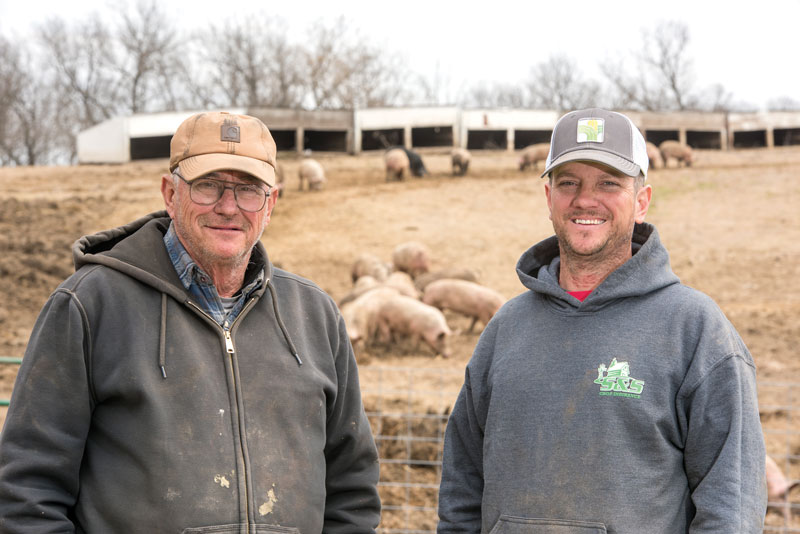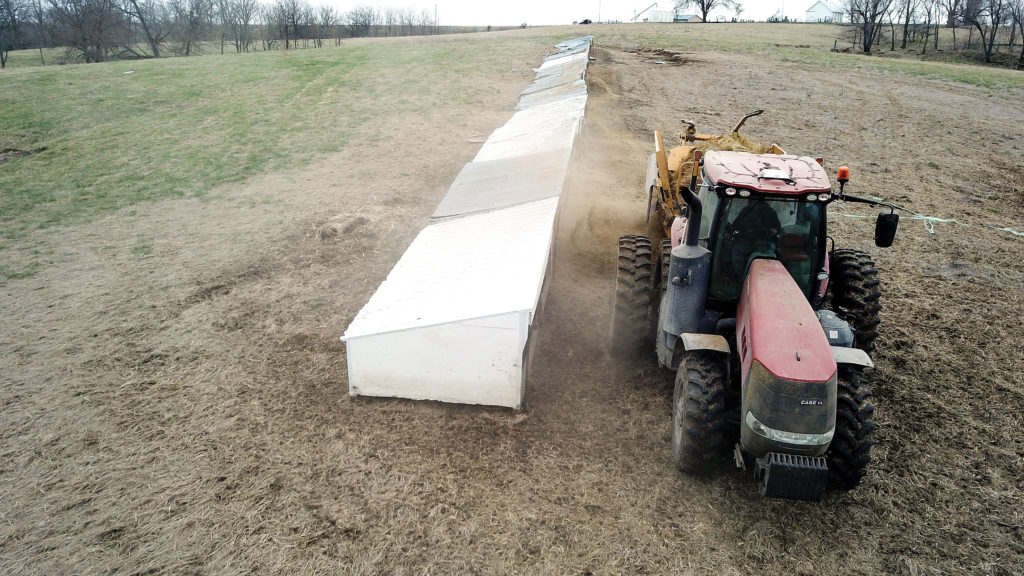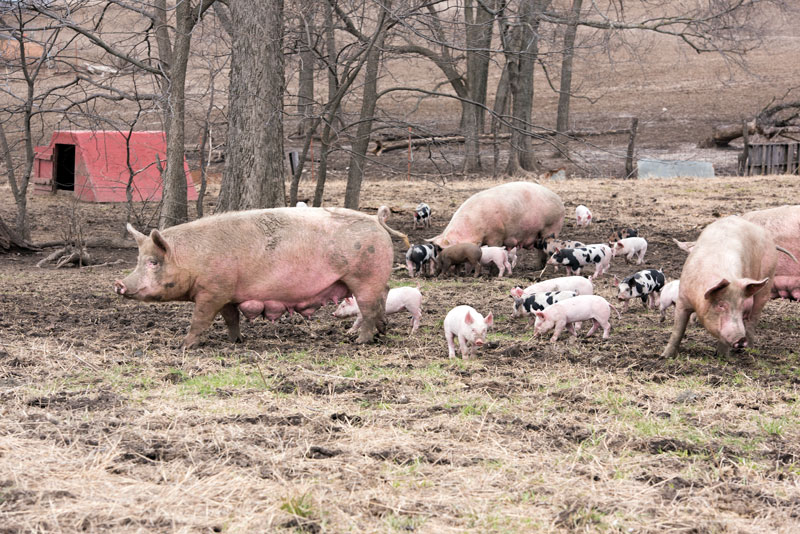
Pigs on Pasture
April 12, 2019
Written By Jason Jenkins
Raising Heritage Breed Hogs Outdoors Links Past and Present for Norton Farms
For the Norton family, tradition runs five generations deep in the rolling hills just outside Plattsburg in northwest Missouri’s Clinton County. Since 1884, the family has followed the same farming formula for success.

“You need to be diversified,” says 73-year-old David Norton, who today operates Norton Farms in partnership with his son, Eric. “That’s the way I learned it.”
It was a lesson brought about by adversity and ingrained by years of perseverance. Today, it manifests itself in the family’s 5,000-acre operation, which includes 3,000 row-crop acres, a 200-head Angus cow/calf herd and a 500-sow farrow-to-finish hog operation. It’s this last piece to the Nortons’ diversification strategy that sets them apart.
Tradition dictated they raise their hogs outdoors on pasture as they have for decades. Diversification dictated that they do it differently in order to succeed.
“We competed on the commodity market for 30 years, but you can’t make any money that way. We’re too small. All the money we’d make in the summer, we’d give it all back in the winter,” explains Eric, the fifth generation of the family to operate the farm. “So, seven years ago, we started raising Berkshire hogs, and two years ago, we joined a non-GMO program. It was either do that or get out of the hog business.
“Now, we have a steady market, and it’s a lot more profitable,” he adds.
Today, the farm annually raises roughly 7,500 Berkshire hogs, most destined for the meat counter at Whole Foods Market locations across the region. Getting them there requires adherence to a set of strict guidelines combined with years of animal husbandry experience in the elements.
Depression Lessons
According to Norton family history—chronicled in “The History of Northwest Missouri: Volume 2,” published in 1915 and edited by Walter Williams, founder of the world’s first school of journalism at the University of Missouri—Asa Norton, Eric’s great-great grandfather, was born in Ohio and was a “gallant soldier” in the Union Army during the Civil War. During his service, he received a wound on his shoulder from a saber.
After the war, he moved to Lebanon, Ind., and married Sarah J. West. The couple headed west to Missouri in 1872, eventually settling in Clinton County in 1884, where they would “improve a valuable farm.” The couple had two sons, including William W. Norton, who was born in 1873.
William established his own successful 235-acre farm 4.5 miles northeast of Plattsburg. He married Annette “Nettie” Transue in 1900, and they also had two sons: William Ralph, who died in 1923 at the age of 19, and Robert Rea. Regarded as “people of thrift and wholesome character,” their home was described as one of the social centers for the Plattsburg community.
“The Norton home is well furnished, occupies a pleasant site, and all the surroundings are in keeping with business-like agriculture,” recounts the 1915 history book. “Mr. Norton has considerable bottom land, and about ten acres in alfalfa. He raises stock, pastures a number of head of cattle, and has a reputation among the neighbors for almost invariable success in all his ventures.”
That success came crashing down along with the stock market in 1929 and the Great Depression that followed.
“My grandfather lost almost everything,” David recalls. “All that was left was what my great-grandmother had.”
Robert Rae, David’s father, was 18 years old when the stock market crashed and he watched his father’s agricultural endeavors succumb in the economic downturn that followed. He vowed to get the family farm back, and with the help of his sons, David and Wesley, he did just that by the 1960s.
David and Wesley attended the University of Missouri and received degrees in animal husbandry and agricultural economics, respectively. They returned to the farm and continued expanding their family’s operation. Robert Rae lived to the age of 91 and was able to witness his grandson, Eric, join the operation as a partner. Today, Eric and wife, Melissa, have two children—5-year-old Dylan and 2-year-old Milia—who represent the sixth generation of Nortons in the family’s now-175-year farming legacy in Clinton County.
Heritage Husbandry
With more than three decades of experience raising commercial hogs outdoors, the Nortons had no reservations when they converted their drove to the Berkshire heritage breed in 2012. After all, the breed itself has a history as rich as the family’s.
According to legend espoused by the American Berkshire Association, the world’s oldest swine registry, the Berkshire hog was discovered by English military leader Oliver Cromwell more than 300 years ago in the county of Berks, home to the famed royal residence Windsor Castle. It is believed the first Berkshires were brought to the United States in 1823.
While overall leanness has been emphasized by the pork industry for years, Berkshire hogs produce a whole carcass that is well-marbled, making cuts such as hams, loins and shoulders more tender and juicier. Eric says when it comes to a taste test, there’s no comparison.
“You can definitely tell the difference between one of our pork chops and one that came out of a finishing barn,” he says. “Cook them side by side on the grill. Ours will be nice and juicy and flavorful versus a hard piece of leather.”
Raising Berks is quite similar to raising other hogs outdoors. Bred Berkshire sows have a gestation period of three months, three weeks and three days—just like other breeds. The Nortons breed their sows twice a year so that farrowing is concentrated in the months of January and July. Typically, they run about 350 sows in the winter and as many as 500 in the summer.
“We try to avoid spring planting and fall harvest, so we end up farrowing at the hottest time and the coldest time of the year,” Eric says. “Hopefully, we’ll have 500 litters this summer.”
The Nortons have kept their drove closed for more than 30 years to protect against inadvertently introducing parasites or diseases. To infuse genetic diversity, they employ artificial insemination to produce their own boars.
“We get the best Berkshire money can buy out of a bottle, and twice a year, we’ll AI 15 to 20 sows,” Eric explains. “We’ll keep the boars out of those litters to serve as our breeding stock.”
At farrowing, litters average around 12 piglets, though stillborn and other losses result in about eight piglets per litter that reach a weaning age of 6 weeks. Eric says the weather plays a significant role in how many piglets survive.
“That’s our biggest concern—heat in the hundreds and below-zero, wet weather is what kills,” he says, noting the stretches of subzero weather this past February and March reduced their winter average to seven piglets. “But, if you can get them from 6 weeks to 12 weeks, you’ve pretty much got it in the bag.”
Predation by coyotes also can be an issue, especially in late winter when food becomes scarce and piglets are an irresistible temptation. Such was the case last March.
“If the sows are still with them, you’re good, but once you wean, it’s open season,” Eric says. “We pulled the sows on a Friday, and the coyotes were already into them on Saturday.”
Once weaned, the pigs remain outside on pasture and are fed out until they reach a weight of 250 pounds and head to market.
Old School in a New Way
While the Nortons don’t market their pork directly to consumers, changes in consumer preferences and expectations about food and food production have led the family to raise their Berkshires following guidelines established by the Global Animal Partnership (GAP).
“The whole world is changing,” Eric says. “It used to be no big deal what kind of corn or soybeans you fed, as long as the hogs made it to market at the right size. Now, everybody wants to know where their meat came from, what it was fed and how the animals lived.”
Ironically, this “new” way of thinking ties in well with many of the Nortons’ “old-school” husbandry methods. Eric says each animal is required have 9 to 12 square feet of space, which isn’t an issue when raising pigs on pasture. Shelter and bedding are both requirements, too, and the Norton farm is dotted with hundreds of traditional, A-frame hog “huts” grouped together in little shanty villages — as has been the case for years. Recently, they also constructed a number of larger hoop houses to serve as shelter. Hay is used for bedding.
“We go through a ton of bedding,” Eric adds. “We bed twice a week in the wintertime. If the weather’s bad, we’ll bed every other day.”
The Berks are fed a diet of conventional corn and soybean meal. The Nortons grow and grind their own non-GMO corn—they expect to plant 1,200 acres this year—and they purchase non-GMO soybean meal. At the height of feeding, Eric says the pigs receive as much as 100 tons of feed per week, all of which is mixed on the farm. No antibiotics are allowed in the feed or the water supply.
Perhaps the biggest change is the amount of paperwork required.
“We actually get GAP audited once a year to keep our certification and make sure we’re doing all the processes that everyone wants,” says Eric, who turns 40 this year. “We record everything, from the weather every day to what they eat and when they eat it.”
Of course, the pigs themselves know nothing of audits or requirements or certification. They’re just busy being pigs.
“They eat, sleep, drink,” Eric says with a laugh. “They roam and root, get into stuff and test the fences. Honestly, I wouldn’t know how to raise them any different.”




